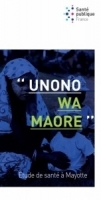Chikungunya is an arboviral disease transmitted by the Aedes mosquitoes, causing arthralgia that can progress to chronic disabling arthritis. Although the 2023 season for specifically monitoring mosquito-borne diseases in mainland France has just started (1 May), an article was published this month discussing the chikungunya epidemic in Mayotte and, more generally, the islands in the Indian Ocean, in 2005-2006.
In Mayotte, a French overseas department, a third of the population was affected, i.e. around 40,000 cases. At that time, a serological survey aiming to determine the prevalence of anti-chikungunya antibodies demonstrated that the recent infection rate assessed by the presence of IgM was 26% in April 2006 highlighting the introduction of the chikungunya virus in Mayotte in 2005, leading to the massive epidemic on the island in 2006.
This outbreak put immense stress on the health monitoring system, the healthcare system and crisis management organisation. It demonstrated the urgent need to step up epidemiological monitoring capacities for mosquito-borne diseases and prevention at local and regional level. In 2008, in Mayotte, the monitoring system for chikungunya and dengue dating from 2006 was expanded by routine patient screening.
The seroprevalence1 study, recently published in the PLOS One journal [1], provides key elements for anticipating the effects of new introduction of the chikungunya virus in this already highly vulnerable territory.
What is the level of population protection against chikungunya infection, more than ten years after this epidemic? What are the sociodemographic factors, knowledge and attitudes towards the prevention of mosquito-borne disease?
3 questions to Giusepina Ortu, EPIET, Infectious Diseases Department, Santé publique France and Harold Noël, Infectious Diseases Department, Santé publique France.


1- This study was conducted as part of EPIET training
The 2006 epidemic was a major health event during which, according to Sissoko et al., 37% of Mayotte inhabitants were infected with the chikungunya virus transmitted via mosquito bite, notably by the tiger mosquito Aedes albopictus. Our study is based on the representative sample of the Mayotte population from the Unono Wa Maore health survey, from December 2018 to June 2019. It aims to document the risk of the emergence of a new epidemic after more than 10 years of low or non-existent chikungunya virus circulation.
We were thus able to estimate the proportion of inhabitants of Mayotte carrying antibodies to the chikungunya virus using serological analyses from the Centre National de Référence des Arbovirus de Marseille-IHU Méditerranée on blood samples of around 2800 participants in the "Unono wa Maore" survey over 15 years of age.
Vaccine trial data, chikungunya epidemiology and data from animal studies suggest that recovery from chikungunya offers long-lasting, even lifetime protection against reinfection. Thus, this proportion of protected persons gives the whole Mayotte population a level of collective immunity which, if this is at least equal to 2006, is likely to prevent large-scale epidemics when viruses from Africa or Asia are introduced. However, this collective immunity is affected by the dynamics of the demographics in Mayotte where, in particular, the 10,000 annual births have no protection against the virus.
Our study suggests that, with a chikungunya seroprevalence of 34.75%, the level of protection against the chikungunya virus would remain relatively preserved in 2019 among Mayotte inhabitants aged 15 years. However, bearing in mind that 44% of the Mayotte population is aged under 15 years, only 20% of the total population would have already encountered the virus. An epidemic could therefore easily occur if the chikungunya virus were introduced.
By comparing our seroprevalence results with data from "Unono wa Maore", we were able to demonstrate a strong link between exposure to chikungunya and the social determinants for health and living conditions. In particular, the risk of exposure increases with a lower level of education, precarious housing, and lack of access to safe drinking water or to toilets in their home. These latter factors reflect the delicate health situation in Mayotte, currently exacerbated by the water shortage on the island, together with social and economic difficulties.
Given this decline in collective immunity in Mayotte, it is important to get ahead as quickly as possible in developing effective vaccines, a sustainable solution to prevent epidemics. The Mayotte population will also have to be involved in the fight against vectors by reducing the mosquito larvae present in and around their homes (water collection in bowls, waste, etc.). It is important that the Regional Health Agency (ARS) and the Santé publique France Regional Unit in Mayotte maintain a high level of sensitivity in the epidemiological monitoring of arboviruses in order to detect the introduction of these viruses as early as possible in order to control the onset of local transmission of the virus through mosquito control measures.
[1] Ortu G, Grard G, Parenton F, Ruello M, Paty M-C, Durand GA, et al. (2023) Long lasting anti-IgG chikungunya seropositivity in the Mayotte population will not be enough to prevent future outbreaks: A seroprevalence study, 2019.
The Unono wa Maore survey

In 2018, Santé publique France set in place a general population survey ("About the Mayotte population") to assess the health needs of the population and implement appropriate prevention and health promotion campaigns. Blood samples were taken and made available for a series of tests.
This survey provided an opportunity to assess the seroprevalence of various arbovirus infections, including CHIKV. Alongside sample collection, sociodemographic data were gathered, together with information on attitudes and practices in the prevention of vector-borne diseases.
In Mayotte :
- Syndromes dengue-like à Mayotte. Point au 10 juillet 2021. Santé publique France
- Sissoko D, Moendandze A, Malvy D, Giry C, Ezzedine K, Solet JL, Pierre V. Seroprevalence and risk factors of chikungunya virus infection in Mayotte, Indian Ocean, 2005-2006: a population-based survey. PLoS One. 2008 Aug 26;3(8):e3066. doi: 10.1371/journal.pone.0003066. PMID: 18725980; PMCID: PMC2518850.
in mainland France :
- On the 2025-2026 epidemic:
- Sissoko D, Delmas G, Giry C, Petinelli F, Saidali R, Gabrie P, Abaine A, Paquet C, Pierre V. Massive outbreak of chikungunya fever in Mayotte Island, France in 2005-2006: a description based on two epidemiological surveys. Bull Epidémiol Hebd. 2007;48-49:405-7.
- Renault P, Sissoko D, Ledrans M, Pierre V, Brucker G. Chikungunya outbreak on the Reunion Island and Mayotte, France, 2005-2006: context and questions raised for surveillance and evaluation. Bull Epidémiol Hebd. 2008;38-39-40:343-6.
- Information report submitted by the Cultural, Family and Social Commission on the chikungunya virus in La Réunion and Mayotte.